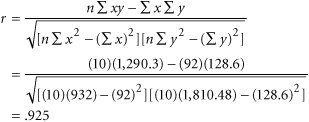Example Problem Solutions
| Period | Units |
|---|---|
| 1 | 56 |
| 2 | 61 |
| 3 | 55 |
| 4 | 70 |
| 5 | 66 |
| 6 | 65 |
| 7 | 72 |
| 8 | 75 |
Develop an exponential smoothing forecast, using a = .40, and an adjusted exponential smoothing forecast, using a = .40 and b = .20. Compare the accuracy of the two forecasts, using MAD and cumulative error.
Solution
| Step 1. | Compute the Exponential Smoothing Forecast F t +1 = a D t + (1 a ) F t For period 2 the forecast ( assuming that F 1 = 56) is F 2 = a D 1 + (1 a ) F 1 = (.40)(56) + (.60)(56) = 56 For period 3 the forecast is F 3 = (.40)(61) + (.60)(56) = 58 The remaining forecasts are computed similarly and are shown in the table on page 704. | ||||||||||||||||||||||||||||||||||||||||||||||||||||||||||||||||||
| Step 2. | Compute the Adjusted Exponential Smoothing Forecast
| ||||||||||||||||||||||||||||||||||||||||||||||||||||||||||||||||||
| Step 3. | Compute the MAD Values | ||||||||||||||||||||||||||||||||||||||||||||||||||||||||||||||||||
| Step 4. | Compute the Cumulative Error The following problem provides an example of the computation of a linear regression forecast. |
Problem Statement
A local building products store has accumulated sales data for two-by-four lumber (in board feet) and the number of building permits in its area for the past 10 quarters :
| Quarter | Building Permits, x | Lumber Sales (1,000s of bd. ft.), y |
|---|---|---|
| 1 | 8 | 12.6 |
| 2 | 12 | 16.3 |
| 3 | 7 | 9.3 |
| 4 | 9 | 11.5 |
| 5 | 15 | 18.1 |
| 6 | 6 | 7.6 |
| 7 | 5 | 6.2 |
| 8 | 8 | 14.2 |
| 9 | 10 | 15.0 |
| 10 | 12 | 17.8 |
Develop a linear regression model for these data and determine the strength of the linear relationship by using correlation. If the model appears to be relatively strong, determine the forecast for lumber, given 10 building permits in the next quarter.
Solution
| Step 1. | Compute the Components of the Linear Regression Equation |
| Step 2. | Develop the Linear Regression Equation y = a + bx y = 1.36 + 1.25 x |
| Step 3. | Compute the Correlation Coefficient |
| Step 4. | Calculate the Forecast for x = 10 Permits |
EAN: 2147483647
Pages: 358



